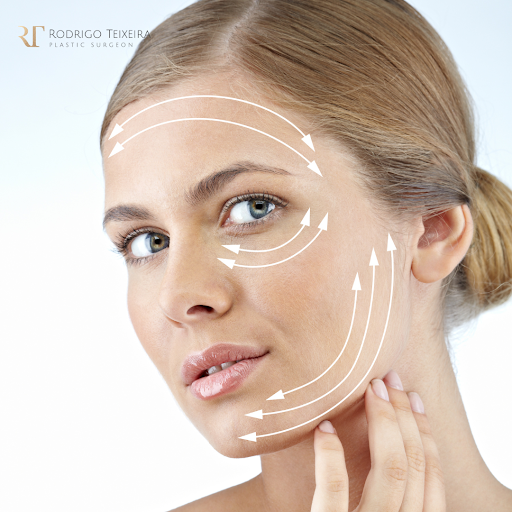
Create a more permanent youthful appearance with facial contouring and fat grafting.
Facial contouring and fat grafting are popular elective cosmetic procedures that can be combined to help rejuvenate the face and create a more youthful and vibrant appearance.
If other cosmetic options have been pursued and did not yield the desired results, or if you would like more durable results with the benefit of promoting skin regeneration, facial contouring with fat grafting may be the best option for you.
In this blog, we discuss the following topics:
- Overview of various facial contouring methods
- Enhancing Facial Proportions and Achieving a Smooth Contour
- Fat Grafting for Reconstructive and Aesthetic Treatments
- The benefits of Fat Grafting
- Recovery after fat injections
A great option for clients looking for an alternative to fillers
1. Overview of various facial contouring methods:
Facial contouring refers to the use of various techniques to enhance or reshape the facial features. There are several different methods of facial contouring, some of which are non-invasive and temporary, while others involve surgery and offer more permanent results. Here is an overview of some of the most common facial contouring methods:
- Makeup Contouring: This is a non-invasive and temporary method of contouring the face. It involves the use of makeup to create the illusion of shadows and highlights, which can help to enhance or reshape the facial features.
- Facial Fillers: This method involves injecting a filler substance, such as hyaluronic acid or collagen, into the face to add volume or contour specific areas. The results typically last several months to a year.
- Botox: This method involves injecting botulinum toxin into the face to relax specific muscles, which can help to smooth out wrinkles and fine lines. The results typically last several months.
- Facial Implants: This method involves surgically placing implants, such as silicone or Gore-Tex, under the skin to enhance or reshape specific facial features, such as the cheeks or chin. The results are permanent.
- Fat Grafting: This method involves removing fat from one part of the body, such as the thighs or abdomen, and injecting it into the face to add volume or contour specific areas. The results are typically long-lasting.
- Face Lift: This method involves surgically tightening the skin and underlying tissues of the face to reduce sagging and create a more youthful appearance. The results are long-lasting.
- Facial Liposuction: This method involves surgically removing excess fat from the face and neck to create a more defined jawline and neck contour. The results are permanent.
Facial Rejuvenation and Contouring: Non-Surgical and Minimally Invasive Options
As we age, our natural collagen production decreases, causing ligaments to loosen and facial volume to diminish. Fortunately, a multi-modal approach to facial rejuvenation can combat these signs of ageing using both non-surgical and surgical treatments tailored to your unique needs.
Consulting with an experienced facial plastic surgeon is essential to determine the right facial contouring method for you, as each option carries its own benefits and risks. In this blog post, we’ll focus on non-surgical facial contouring and minimally invasive facial fat grafting.
2. Enhancing Facial Proportions and Achieving a Smooth Contour
Facial contouring, also known as facial sculpting, is a procedure that restores facial shape and creates more natural facial proportions. Its goal is to enhance facial features and replace volume loss, resulting in a smooth and defined contour. This versatile procedure can be performed on several areas of the face, including the lips, jawline, cheekbones, brows, and forehead.
Facial sculpting isn’t just for those showing signs of ageing. Clients with a tired look around their eyes, facial asymmetry, flat cheeks, small lips, a jawline lacking definition, or a receding chin can all benefit from this procedure.
Facial Surgery and Rejuvenation
3. Fat Grafting: Autologous Fat Transfer for Reconstructive and Aesthetic Treatments
Fat grafting, also known as autologous fat transfer, is a surgical procedure that involves transferring viable fat tissue from one part of the body to another. This versatile modality is used in a wide range of reconstructive and aesthetic treatments, including facial contouring, to add volume and improve contour.
During the procedure, fat is harvested from areas like the abdomen, flanks, thighs, or inner knees through liposuction, processed for purification, and then moved to the desired treatment area. The fat can be processed through several steps, including cleansing, filtration, purification, and emulsification. Surgeons can also use a centrifuge to separate fat, oil, blood, and fluids, and micronize the fat into fine, homogenised tissue without emulsification.
Surgeons can now tailor the fat graft to the procedure, creating different consistencies or viscosities for various applications. Micro-fat grafting is typically used to add fullness to areas of the face that have lost volume, such as the cheeks and jaw, while nano-fat is recommended for fine facial fat grafting and can be used to contour areas around the eyes and mouth. Fine fat gel is used for wrinkles, fine facial lines, and surface treatment to provide a smoother and more youthful appearance.
4. Facial contouring with fat grafting offers a range of benefits that make it an attractive option for those looking to enhance their facial features.
Here are some key benefits to consider:
- Natural-looking results – Fat grafting uses the patient’s own tissue, resulting in a safe and natural-looking enhancement.
- Long-lasting results – Fat grafting can provide longer-lasting results compared to traditional fillers, with some patients seeing results lasting several years.
- Versatility – The procedure can enhance several areas of the face, including the cheeks, jawline, lips, and forehead.
- Customisation – The surgeon can tailor the fat graft to meet the individual patient’s desired results.
- Minimally invasive – The procedure involves small incisions and no general anaesthesia, leading to a faster recovery time compared to more invasive surgical procedures.
- Simultaneous body contouring – The procedure involves liposuction to harvest the fat from other parts of the body, which can result in simultaneous body contouring.

Regenerative properties of Fat grafting:
In addition to the benefits mentioned earlier, facial contouring with fat grafting also has regenerative properties. The fat grafts contain progenitor cells called pre-adipocytes, which can regenerate tissue and promote healing. These cells and some growth factors hormones present in the fat grafting can stimulate the production of collagen and elastin, resulting in improved skin texture and tone.
Moreover, fat grafting can improve blood flow to the treated area, which can promote the growth of new blood vessels and improve overall skin health. The procedure can also boost the skin’s natural hydration levels, leading to a more youthful and radiant appearance.
Overall, facial contouring with fat grafting not only enhances facial features but also provides regenerative benefits that can improve the skin’s health and appearance. This makes it an attractive option for those looking for a natural, minimally invasive approach to facial rejuvenation. Consider consulting with a qualified and experienced plastic surgeon to determine if this procedure is right for you.
5. Recovery after fat injections:
The recovery after facial fat grafting can vary from person to person, but generally, it is a relatively straightforward process. Immediately after the procedure, patients may experience some swelling, bruising, and discomfort in the treated area. However, these side effects are temporary and can be managed with pain medication and cold compresses.
Patients are advised to avoid strenuous physical activity and excessive sun exposure for the first week after the procedure. It is also important to avoid touching or rubbing the treated area, as this can disrupt the healing process and affect the results.
Most patients can resume normal activities within a week or two after the procedure, although the full recovery period may take up to several weeks. The treated area may feel firm or lumpy for a few weeks, but this typically resolves as the grafted fat settles and integrates with the surrounding tissue.
It is essential to follow your surgeon’s post-operative care instructions carefully to ensure optimal results and a smooth recovery.
6. A great option for clients looking for an alternative to fillers
Facial fat grafting has become a popular alternative to dermal fillers for those looking to rejuvenate their appearance. While fillers have been traditionally used to restore volume loss in the face, there are a few concerns associated with their use. These include filler migration, filler fatigue, chronic swelling, infection, and other safety points.
Filler migration occurs when the filler material moves away from the injection site, leading to asymmetry and unnatural contours. Additionally, long-term use of fillers can cause filler fatigue, leading to the need for more frequent injections to maintain the desired results. Chronic swelling and infection can also occur with filler injections, especially in individuals with sensitive skin or allergies.
Overfilling the face with fillers can lead to an unnatural and disproportionate appearance, causing a loss of facial symmetry and balance. This is especially concerning when multiple filler injections are done over a long period of time.
In contrast, facial fat grafting offers a more permanent solution to volume loss in the face. Fat grafting uses the patient’s own fat cells, harvested from another part of the body, to restore volume and contour to the face. Not only does this procedure offer a longer-lasting result, but it also provides regenerative benefits that are not present with fillers.
Facial fat grafting involves minimal risk of infection, as it uses the patient’s own tissue. The procedure is also less likely to cause chronic swelling or allergic reactions since the graft material is natural and biocompatible. Additionally, the regenerative properties of the fat grafting procedure can lead to improved skin texture, tone, and quality over time, as the transplanted fat cells integrate into the surrounding tissue.
Overall, facial fat grafting is a safe and effective alternative to dermal fillers. While fillers have their benefits, the long-term risks associated with their use make facial fat grafting a more appealing option for those looking for a natural and long-lasting solution to facial ageing.
Are you wanting to restore your youthful appearance with facial contouring?
Based in Melbourne, Australia Dr Rodrigo Teixeira is a specialist plastic surgeon specialising in Facial Contouring, Fat Grafting, Rhinoplasty and Breast Augmentation.
If you are considering refreshing your look and would like to find out more about
facial contouring and fat grafting, or any other cosmetic procedure, please feel free to contact Unveil Plastic Surgery in Ivanhoe East.
We would be happy to set up a time with Dr Rodrigo Teixeira, where he can answer any questions and will evaluate your facial structure and skin type to create a personalised treatment plan specific to your unique needs and aesthetic goals.
About Dr Rodrigo Teixeira
Dr Rodrigo Teixeira, MD, FRACS is a Plastic Surgeon in Melbourne. He is highly experienced in Cosmetic Surgery, Rhinoplasty and Facial Surgery. Dr Teixeira is a fellow of the Royal Australasian College of Surgeons (RACS), member of the Australian Society of Plastic Surgeons (ASPS) and Australasian Society of Aesthetic Plastic Surgeons (ASAPS). Internationally, he is a member of the American and the International Societies.